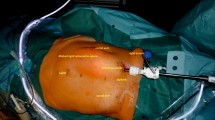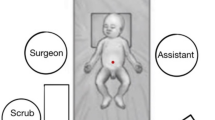Summary
The principle of parietoscopy is the creation of a subcutaneous plane of cleavage in front of the aponeuroses by insufflation of CO2. The aim is the repair of certain hernias and incisional hernias of the abdominal wall without damaging the overlying skin, mainly for cosmetic reasons, especially in young women. In our series access was suprapubic or umbilical depending on the site of the lesion to be repaired. A 10 mm blunt tip trocar was placed in contact with the aponeurotic plane. After initial separation of the subcutaneous tissue, progressive insufflation of CO2 stripped the cutaneous layer extensively upwards and laterally. Using one or two 5 mm trocars, the aponeurotic layer was progressively freed and the affected zones identified. These were repaired by standard endoparietal sutures or by percutaneous sutures using a Reverdin needle. Fifteen patients (14 women and 1 man) with a mean age of 30 years (range 19 to 35) with diastasis of the rectus abdominis muscles (5 cases), incisional hernias (3 cases) or an epigastric or linea alba hernia (7 cases) were treated by parietoscopy. Conversion to a classical approach was necessary in one man with diastasis of the rectus muscles because fibrosis prevented a subcutaneous plane of cleavage. Repair was possible in 14 cases. The mean operative duration was 1h 20 min and that of hospitalisation was 2 days (1–3). There was no mortality or morbidity. The mean follow-up was 18 months (4–40) with excellent cosmetic and functional results. Thus, abdominal parietoscopy allows repair of certain minor parietal lesions with preservation of the overlying skin. Its indications are of a cosmetic nature, in young women with normal skin overlying an abdominal wall defect.
Similar content being viewed by others
References
Barie PS, Mack CA, Thompson WA (1995) A technique for laparoscopic repair of herniation of the anterior abdominal wall using a composite mesh prosthesis. Am J Surg 170:62–63
Champault G (1993) Chirurgie laparoscopique des hernies de l'aine: la voie pré-péritonéale. J Chir (Paris) 131:333–334
Champault G (1996) La pariétoplastie abdominale: technique, indications et résultats préliminaires (7 cas). Ann Chir 50:445–448
Corbitt Jr JD (1993) Transabdominal preperitoneal herniorraphy Surg Lap Endosc 3:328–332
Felix EL, Michas C (1994) Laparoscopic repair of Spigelian hernias Surg Lap Endosc 4: 308–310
Fischer BL (1994) Videoassisted spiegelian hernia repair. Surg Lap Endosc 4:238–240
Hashizume M, Migo S, Tsugawa Y, Tanoue K, Ohta M, Kumashoro R, Sugimachi K (1996) Laparoscopic repair of paraumbilical ventral hernia with increasing size in obese patients. Surg Endosc 10:933–935
Holzman MD, Purut CM, Reintgen K, Eubanks S, Pappas TN (1997) Laparoscopic ventral and incisional hernioplasty. Surg Endosc 11:32–35
Jackson IL, Jackson RF, Freeman L (1995) Minimally invasive abdominoplasty: Surgical technique. Development and report of three cases. Surg Lap Endosc 5:301–305
Leblanc KA, Booth WV (1992) Laparoscopic repair of incisional abdominal hernias using expanded polytetrafluoroethylene: preliminary findings. Surg Laparosc Endosc 3:39–41
McKerman JB, Laws HL (1993) Laparoscopic repair of inguinal hernia using a totally extraperitoneal prosthetic approach. Surg Endosc 7:268
Saiz A, Willis IH (1994) Laparoscopic ventral hernia repair. J Laparoendosc Surg 4:365–367
Author information
Authors and Affiliations
Rights and permissions
About this article
Cite this article
Champault, G.G., Catheline, J.M. & Barrat, C. Parietoscopic treatment of abdominal wall defects: A report of 15 cases. Hernia 3, 15–18 (1999). https://doi.org/10.1007/BF01576734
Received:
Accepted:
Issue Date:
DOI: https://doi.org/10.1007/BF01576734




